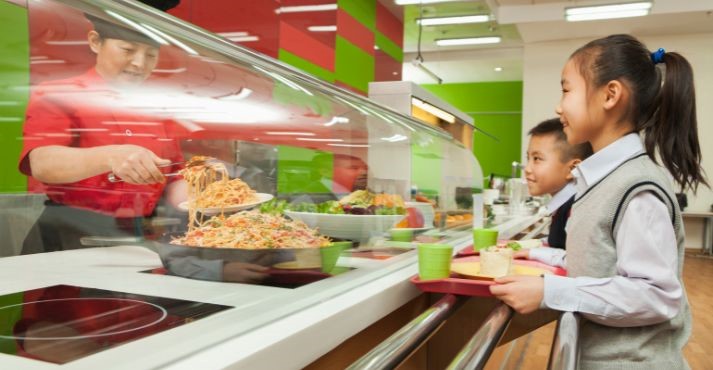Eating out is more than just a meal for the consumers. The food service industry has become a significant factor in shaping our world.
Food service operations involve purchasing raw materials, inventory checks, food preparation, and analyzing the business.
There are two types of food service operations: commercial vs. non-commercial food service. Each category has its unique approach and considerations.
This blog post will examine the key difference between commercial and noncommercial food service operations.
What is a Commercial Food Service?

Commercial food service refers to businesses that prepare and serve food and beverages to customers for a profit.
Commercial food service involves the preparation of diverse cuisines, customer service, and compliance with health and safety regulations to provide a satisfying dining experience for patrons.
Critical characteristics of commercial food service operations include:
- Providing excellent customer service, such as attentive and friendly staff, efficient order processing, and addressing customer needs.
- Consistently preparing high-quality and safe food with strict hygiene practices.
- A diverse and appealing menu caters to different tastes and preferences.
- Efficient operations for managing inventory effectively and optimizing workflow.
- Creating a welcoming and comfortable ambiance to enhance the dining experience.
- Well-trained and knowledgeable staff for smooth operations.
- Adapting to changing consumer trends, market conditions, and external factors.
Types of Commercial Food Service
Here are the most common commercial food service operations:
- Restaurants
The restaurant industry has profit-driven eateries offering diverse menus, often providing table service. Customer-focused on ambiance and service, emphasizing a range of culinary options to attract and retain a broad clientele.
- Cafés
Characterized by a relaxed atmosphere, cafés prioritize diverse coffee and snack options—Profit-driven with customer-centric services.
- Fast-food chains
Profit-oriented establishments with a focus on quick service and standardized menu offerings. Catering to convenience, they provide diverse, affordable, and rapidly prepared food options for a broad customer base.
- Fine dining establishments
High-end, profit-driven venues are known for cuisine, elegant ambiance, and attentive service. Diverse gourmet menus cater to those seeking a premium dining experience.
- Food trucks
Mobile profit-driven enterprises offering diverse, often unique, and quickly prepared foods. Customer-focused on providing accessible and convenient culinary experiences in various locations.
- Catering companies
A catering business is a profit-driven service that provides diverse event menu options. Customer-centric with personalized offerings, emphasizing quality and presentation for catering to special occasions.
- Bakeries
Bakeries are establishments specializing in baked goods. Customer-focused on diverse and fresh pastries, bread, and desserts, often emphasizing artisanal and specialty items to attract a vast clientele.
- Coffee shops
Coffee shops are profit-driven establishments centered around coffee, offering diverse brews and snacks. Customer-centric, providing a relaxed environment for socializing or work while serving various coffee-based beverages.
- Bars and pubs
Profit-driven venues offer diverse alcoholic beverages and often a pub-style menu. Customer-focused on providing a social atmosphere, emphasizing entertainment and a range of drink options.
- Food courts
Food courts are dining areas within shopping centers that offer diverse cuisine options. Customer-centric, providing shoppers with a convenient and varied dining experience with quick-service options.
- Ice cream parlor
Establishments specializing in diverse ice cream offerings. Customer-focused on providing a range of flavors and customizable options, creating a sweet and enjoyable experience.
- Food kiosks
Small-scale outlets offering diverse and often specialized food items. Customer-centric with a focus on convenience, quick service, and unique menu offerings in high-traffic locations.
What is a Non-commercial Food Service?

Non-commercial foodservice refers to operations prioritizing community service over profit, often found in educational institutions, healthcare facilities, and charitable organizations.
These establishments aim to meet diverse dietary needs, considering health and cultural preferences. Unlike their commercial counterparts, non-commercial food services lack a profit motive, channeling resources toward enhancing the well-being of their communities.
Their focus on nutrition, affordability, and inclusivity reflects a commitment to providing essential sustenance while maintaining well-being.
Critical characteristics of non-commercial food service operations include:
- These operations cater to diverse dietary needs, considering health, cultural preferences, and special dietary requirements.
- Non-commercial food service operations aim to provide affordable meal options, mostly paid for by the institution.
- Non-commercial food operations are concerned with covering their costs rather than making profits.
Types of Non-commercial Food Service
Here are the most common non-commercial food service operations:
- Schools
Non-commercial food services in schools focus on providing nutritious and balanced meals to students, supporting their growth and development. These services often follow dietary guidelines and may include educational components promoting healthy eating habits.
- Hospitals
In healthcare settings, non-commercial food services cater to patients with specific dietary needs, supporting their recovery. The focus is nutrition, accommodating medical requirements, and ensuring dietary diversity.
- Government Facilities
Non-commercial food operations in government settings serve employees and visitors. These services prioritize affordability and often follow government guidelines for nutrition, ensuring access to balanced meals for a diverse population.
- Community Centers
These facilities provide non-commercial food services to residents, promoting social cohesion. Meals are often affordable and diverse and may cater to specific community preferences, fostering a sense of inclusivity.
- Charitable Organizations
Non-profit entities focus on community well-being by offering free or subsidized meals to those in need. These operations often rely on donations and volunteers, address hunger, and support vulnerable populations.
Difference between Commercial and Non-commercial Food Service

Commercial and non-commercial food service operations satisfy different customer bases’ food requirements and tastes.
Let’s explore the key differences:
Operational Goals
Commercial food service operations aim primarily to generate profit by offering food and beverage products to paying customers.
The critical operational goals include maximizing revenue, controlling costs, and ensuring customer satisfaction to drive repeat business. The focus on profitability influences menu pricing, marketing strategies, and operational efficiency.
On the other hand, non-commercial food service operations prioritize community service over profit.
Settings such as schools, hospitals, and community centers aim to meet diverse dietary needs and promote health and well-being. Profit generation is the secondary element, striving to cover the essential cost of food operations.
Menu Design and Variety
Menu design in commercial establishments is a strategic process beyond listing dishes, as it reflects the brand, culinary creativity, and market responsiveness.
Commercial food service operations cater to varying tastes, dietary preferences, and cultural influences, attracting a broad customer base.
Commercial establishments often invest in seasonal or trendy items to stay relevant, responding to evolving market preferences and culinary trends.
The menu design in non-commercial food services settings, such as schools, hospitals, and community centers, is driven by the purpose of meeting dietary needs and promoting community health.
The emphasis is on creating menus that support overall well-being and cater to a broad audience.
Dietary Considerations in Non-commercial Food Service
Non-commercial food service establishments, such as schools, healthcare facilities, and community centers, focus on providing balanced and nutritious meals that support the well-being of individuals with varying health conditions, cultural backgrounds, and dietary preferences.
For instance, non-commercial food services in schools often adhere to nutritional guidelines to ensure students receive well-rounded meals, contributing to their growth and development.
Likewise, in healthcare facilities, menus are designed to meet patients’ dietary restrictions and nutritional needs, considering medical conditions and recovery goals.
Moreover, community centers may cater to populations with specific cultural or religious dietary restrictions, ensuring inclusivity.
Pricing and Cost Structure
Running a commercial food service isn’t cheap; operating costs increase quickly. Pricing strategies in commercial food service are multifaceted, shaped by market dynamics, competition, and profit considerations.
Market forces, such as supply and demand, impact ingredient costs and availability, influencing menu pricing. Additionally, pricing decisions are tied to profit margins, with establishments aiming to cover costs while maximizing revenue.
A well-designed pricing strategy ensures that your menu reflects your restaurant’s value while being profitable and appealing to your target audience.
Commonly adopted pricing strategies for commercial food service include:
- Cost-plus pricing: Determining menu prices by adding a markup percentage to the total cost of ingredients and preparation. Ensures costs are covered and provides a predictable profit margin.
- Value-based pricing: Setting prices based on the perceived value of the dining experience, considering factors like quality, ambiance, and service. Emphasizes customer perception and satisfaction.
- Dynamic pricing: Adjusting menu prices in real-time based on factors like demand, time of day, or season. Maximizes revenue during peak periods and encourages off-peak business with lower prices.
- Bundle pricing: Offering meal packages or combos at a lower price than individual items. Encourages upselling, enhances perceived value, and simplifies customer decision-making, often boosting overall sales.
For example, high-end restaurants may employ premium pricing strategies, emphasizing exclusivity and superior quality. In contrast, fast-food chains often adopt value-based pricing, focusing on affordability and quick service.
Funding and Budgeting in Non-commercial Food Service
Funding for non-commercial food services, such as schools and healthcare facilities, is typically derived from government allocations, institutional budgets, and charitable contributions.
- Government allocations: Schools and hospitals receive funding from government budgets, ensuring financial support for meal programs that promote health and well-being among the population.
- Institutional budgets: Organizations allocate internal funds for non-commercial food services, covering expenses such as ingredients, staff salaries, and equipment.
- Charitable contributions: Non-profit and charitable organizations supporting food services rely on donations from individuals, businesses, and foundations. These contributions help expand services, reach more people, and enhance the quality of meals.
- Grants: Grants from government agencies or private foundations are provided to non-commercial foodservice operators. These funds support specific initiatives, such as nutrition education programs or infrastructure improvements, contributing to the overall mission of the service.
Budget considerations for non-commercial establishments include allocating resources for ingredients, kitchen equipment, staff salaries, and related expenses. These entities prioritize cost-effectiveness to provide nutritious meals within allocated funds.
Conclusion
Commercial food service vs non-commercial food service differ based on operational goals, funding sources, and approaches to menu design.
Commercial food service operators prioritize profit, tailoring menus to diverse consumer preferences and market trends.
Non-commercial services, driven by community well-being, focus on meeting diverse dietary needs in settings like schools and hospitals, relying on government allocations and charitable contributions.
These distinctions shape everything for commercial and non-commercial food service establishments.













